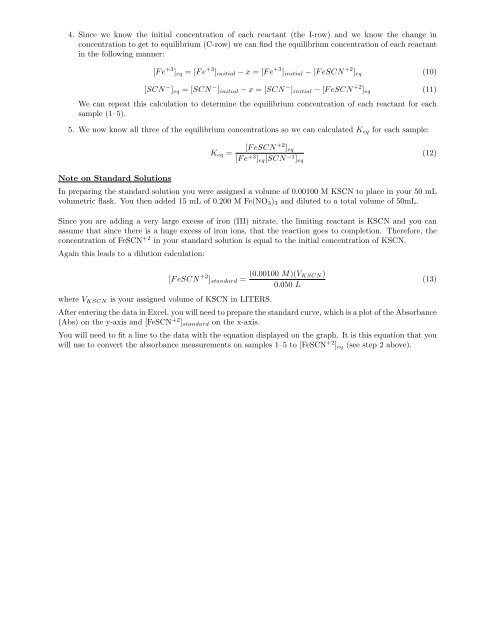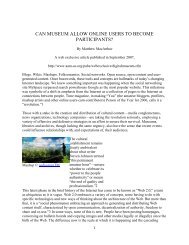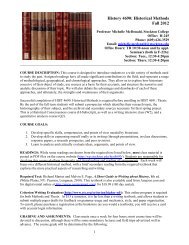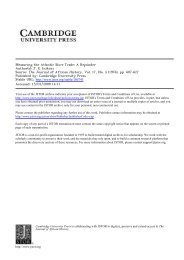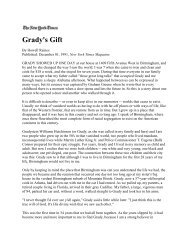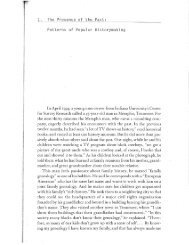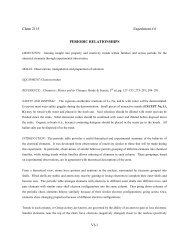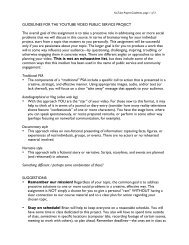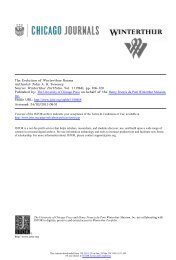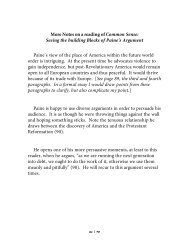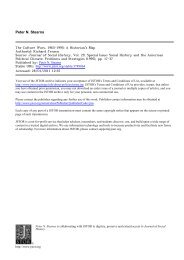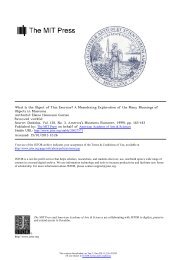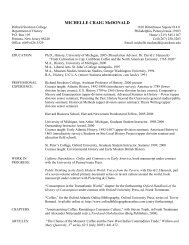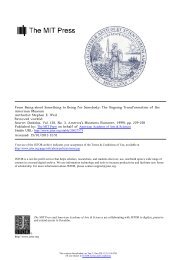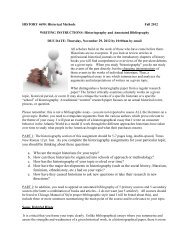The Richard Stockton College of New Jersey CHEM 2115: General ...
The Richard Stockton College of New Jersey CHEM 2115: General ...
The Richard Stockton College of New Jersey CHEM 2115: General ...
You also want an ePaper? Increase the reach of your titles
YUMPU automatically turns print PDFs into web optimized ePapers that Google loves.
4. Since we know the initial concentration <strong>of</strong> each reactant (the I-row) and we know the change in<br />
concentration to get to equilibrium (C-row) we can find the equilibrium concentration <strong>of</strong> each reactant<br />
in the following manner:<br />
[F e +3 ]eq = [F e +3 ]initial − x = [F e +3 ]initial − [F eSCN +2 ]eq<br />
[SCN − ]eq = [SCN − ]initial − x = [SCN − ]initial − [F eSCN +2 ]eq<br />
We can repeat this calculation to determine the equilibrium concentration <strong>of</strong> each reactant for each<br />
sample (1–5).<br />
5. We now know all three <strong>of</strong> the equilibrium concentrations so we can calculated Keq for each sample:<br />
Note on Standard Solutions<br />
Keq =<br />
[F eSCN +2 ]eq<br />
[F e +3 ]eq[SCN −1 ]eq<br />
In preparing the standard solution you were assigned a volume <strong>of</strong> 0.00100 M KSCN to place in your 50 mL<br />
volumetric flask. You then added 15 mL <strong>of</strong> 0.200 M Fe(NO3)3 and diluted to a total volume <strong>of</strong> 50mL.<br />
Since you are adding a very large excess <strong>of</strong> iron (III) nitrate, the limiting reactant is KSCN and you can<br />
assume that since there is a huge excess <strong>of</strong> iron ions, that the reaction goes to completion. <strong>The</strong>refore, the<br />
concentration <strong>of</strong> FeSCN +2 in your standard solution is equal to the initial concentration <strong>of</strong> KSCN.<br />
Again this leads to a dilution calculation:<br />
[F eSCN +2 ]standard =<br />
where VKSCN is your assigned volume <strong>of</strong> KSCN in LITERS.<br />
(0.00100 M)(VKSCN)<br />
0.050 L<br />
After entering the data in Excel, you will need to prepare the standard curve, which is a plot <strong>of</strong> the Absorbance<br />
(Abs) on the y-axis and [FeSCN +2 ]standard on the x-axis.<br />
You will need to fit a line to the data with the equation displayed on the graph. It is this equation that you<br />
will use to convert the absorbance measurements on samples 1–5 to [FeSCN +2 ]eq (see step 2 above).<br />
(10)<br />
(11)<br />
(12)<br />
(13)


